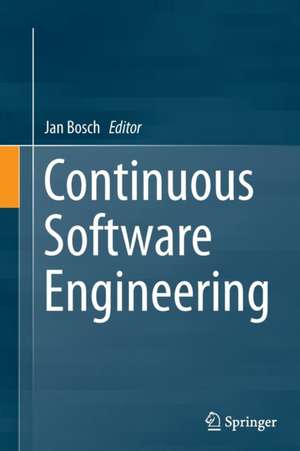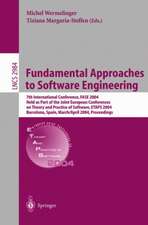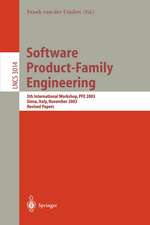Continuous Software Engineering
Editat de Jan Boschen Limba Engleză Paperback – 23 aug 2016
The 17 chapters present the “Stairway to Heaven” model, which represents the typical evolution path companies move through as they develop and mature their software engineering capabilities. The chapters describe theoretical frameworks, conceptual models and, most importantly, the industrial experiences gained by the partner companies in applying novel software engineering techniques.
The book’s structure consists of six parts. Part I describes the model in detail and presents an overview of lessons learned in the collaboration between industry and academia. Part II deals with the first step of the Stairway to Heaven, in which R&D adopts agile work practices. Part III of the book combines the next two phases, i.e., continuous integration (CI) and continuous delivery (CD), as they are closely intertwined. Part IV is concerned with the highest level, referred to as “R&D as an innovation system,” while Part V addresses a topic that is separate from the Stairway to Heaven and yet critically important in large organizations: organizational performance metrics that capture data, and visualizations of the status of software assets, defects and teams. Lastly, Part VI presents the perspectives of two of the SC partner companies.
The book is intendedfor practitioners and professionals in the software-intensive systems industry, providing concrete models, frameworks and case studies that show the specific challenges that the partner companies encountered, their approaches to overcoming them, and the results. Researchers will gain valuable insights on the problems faced by large software companies, and on how to effectively tackle them in the context of successful cooperation projects.
| Toate formatele și edițiile | Preț | Express |
|---|---|---|
| Paperback (1) | 329.76 lei 6-8 săpt. | |
| Springer International Publishing – 23 aug 2016 | 329.76 lei 6-8 săpt. | |
| Hardback (1) | 336.02 lei 6-8 săpt. | |
| Springer International Publishing – 24 noi 2014 | 336.02 lei 6-8 săpt. |
Preț: 329.76 lei
Preț vechi: 412.21 lei
-20% Nou
Puncte Express: 495
Preț estimativ în valută:
63.11€ • 65.64$ • 52.10£
63.11€ • 65.64$ • 52.10£
Carte tipărită la comandă
Livrare economică 14-28 aprilie
Preluare comenzi: 021 569.72.76
Specificații
ISBN-13: 9783319364704
ISBN-10: 3319364707
Pagini: 240
Ilustrații: XIV, 226 p. 50 illus., 30 illus. in color.
Dimensiuni: 155 x 235 x 13 mm
Greutate: 0.35 kg
Ediția:Softcover reprint of the original 1st ed. 2014
Editura: Springer International Publishing
Colecția Springer
Locul publicării:Cham, Switzerland
ISBN-10: 3319364707
Pagini: 240
Ilustrații: XIV, 226 p. 50 illus., 30 illus. in color.
Dimensiuni: 155 x 235 x 13 mm
Greutate: 0.35 kg
Ediția:Softcover reprint of the original 1st ed. 2014
Editura: Springer International Publishing
Colecția Springer
Locul publicării:Cham, Switzerland
Cuprins
Part I Introduction.- 1 Continuous Software Engineering: An Introduction.- 2 Climbing the “Stairway to Heaven”: Evolving From Agile Development to Continuous Deployment of Software.- 3 Academia–Industry Collaboration: Getting Closer is the Key!.- Part II Agile Practices.- 4 Role of Architects in Agile Organizations.- 5 Teams Interactions Hindering Short-Term and Long-Term Business Goals.- 6 A Framework for Speeding Up Interactions Between Agile Teams and Other Parts of the Organization.- 7 Customer-Specific Teams for Agile Evolution of Large-Scale Embedded Systems.- Part III Continuous Integration.- 8 The CIViT Model in a Nutshell: Visualizing Testing Activities to Support Continuous Integration.- 9 Continuous Integration Flows.- 10 Towards Continuous Integration for Cyber-Physical Systems on the Example of Self-Driving Miniature Cars.- 11 Industrial Application of Visual GUI Testing: Lessons Learned.- Part IV R&D as an Innovation System.- 12 Post-deployment Data Collection in Software-Intensive Embedded Products.- 13 The HYPEX Model: From Opinions to Data-Driven Software Development.- Part V Organizational Performance Metrics.- 14 Profiling Prerelease Software Product and Organizational Performance.- 15 Industrial Self-Healing Measurement Systems.- Part VI Industry Best Practices and Case Studies.- 16 Experiences from Implementing Agile Ways of Working in Large-Scale System Development.- 17 Scaling Agile Mechatronics: An Industrial Case Study.
Notă biografică
Jan Bosch is Professor of Software Engineering and Director of the Software Center at Chalmers University of Technology in Gothenburg, Sweden. Earlier, he worked as Vice President Engineering Process at Intuit Inc., and as Head of the Software and Application Technologies Laboratory at the Nokia Research Center, Finland. His research activities include open innovation, innovation experiment systems, compositional software engineering, software ecosystems, software architecture, software product families and software variability management.
In the start-up space, Jan is Chairman of the Board of Fidesmo in Stockholm, and Remente, in Gothenburg, Sweden. He serves on the advisory board of Assia Inc. in Redwood City, CA, as well as on the advisory board of Burt, in Gothenburg, Sweden.
As a consultant, as a professor and as an employee, Jan has worked with and for many companies on innovation and R&D management, including Philips, Thales Naval Netherlands, Robert Bosch GmbH, Siemens, Nokia, Ericsson, Grundfos, Tellabs, Avaya, Tieto Enator and Det Norska Veritas.
In the start-up space, Jan is Chairman of the Board of Fidesmo in Stockholm, and Remente, in Gothenburg, Sweden. He serves on the advisory board of Assia Inc. in Redwood City, CA, as well as on the advisory board of Burt, in Gothenburg, Sweden.
As a consultant, as a professor and as an employee, Jan has worked with and for many companies on innovation and R&D management, including Philips, Thales Naval Netherlands, Robert Bosch GmbH, Siemens, Nokia, Ericsson, Grundfos, Tellabs, Avaya, Tieto Enator and Det Norska Veritas.
Textul de pe ultima copertă
This book provides essential insights on the adoption of modern software engineering practices at large companies producing software-intensive systems, where hundreds or even thousands of engineers collaborate to deliver on new systems and new versions of already deployed ones. It is based on the findings collected and lessons learned at the Software Center (SC), a unique collaboration between research and industry, with Chalmers University of Technology, Gothenburg University and Malmö University as academic partners and Ericsson, AB Volvo, Volvo Car Corporation, Saab Electronic Defense Systems, Grundfos, Axis Communications, Jeppesen (Boeing) and Sony Mobile as industrial partners.
The 17 chapters present the “Stairway to Heaven” model, which represents the typical evolution path companies move through as they develop and mature their software engineering capabilities. The chapters describe theoretical frameworks, conceptual models and, most importantly, the industrial experiences gained by the partner companies in applying novel software engineering techniques.
The book’s structure consists of six parts. Part I describes the model in detail and presents an overview of lessons learned in the collaboration between industry and academia. Part II deals with the first step of the Stairway to Heaven, in which R&D adopts agile work practices. Part III of the book combines the next two phases, i.e., continuous integration (CI) and continuous delivery (CD), as they are closely intertwined. Part IV is concerned with the highest level, referred to as “R&D as an innovation system,” while Part V addresses a topic that is separate from the Stairway to Heaven and yet critically important in large organizations: organizational performance metrics that capture data, and visualizations of the status of software assets, defects and teams. Lastly, Part VI presents the perspectives of two of the SC partner companies.
The book is intendedfor practitioners and professionals in the software-intensive systems industry, providing concrete models, frameworks and case studies that show the specific challenges that the partner companies encountered, their approaches to overcoming them, and the results. Researchers will gain valuable insights on the problems faced by large software companies, and on how to effectively tackle them in the context of successful cooperation projects.
The 17 chapters present the “Stairway to Heaven” model, which represents the typical evolution path companies move through as they develop and mature their software engineering capabilities. The chapters describe theoretical frameworks, conceptual models and, most importantly, the industrial experiences gained by the partner companies in applying novel software engineering techniques.
The book’s structure consists of six parts. Part I describes the model in detail and presents an overview of lessons learned in the collaboration between industry and academia. Part II deals with the first step of the Stairway to Heaven, in which R&D adopts agile work practices. Part III of the book combines the next two phases, i.e., continuous integration (CI) and continuous delivery (CD), as they are closely intertwined. Part IV is concerned with the highest level, referred to as “R&D as an innovation system,” while Part V addresses a topic that is separate from the Stairway to Heaven and yet critically important in large organizations: organizational performance metrics that capture data, and visualizations of the status of software assets, defects and teams. Lastly, Part VI presents the perspectives of two of the SC partner companies.
The book is intendedfor practitioners and professionals in the software-intensive systems industry, providing concrete models, frameworks and case studies that show the specific challenges that the partner companies encountered, their approaches to overcoming them, and the results. Researchers will gain valuable insights on the problems faced by large software companies, and on how to effectively tackle them in the context of successful cooperation projects.
Caracteristici
Provides essential insights on the adoption of modern software engineering practices at large companies producing software-intensive systems Presents the “Stairway to Heaven” model, which supports a continuous evolution path to mature software engineering capabilities Describe theoretical frameworks, conceptual models and industrial experiences in applying novel software engineering techniques Includes supplementary material: sn.pub/extras






























